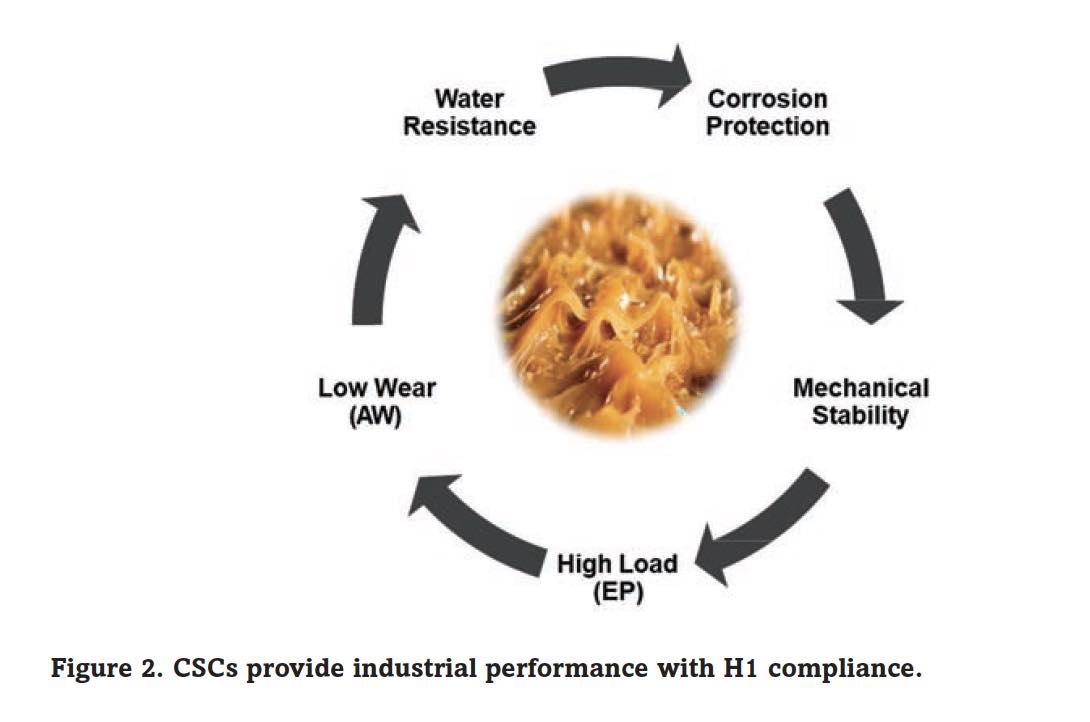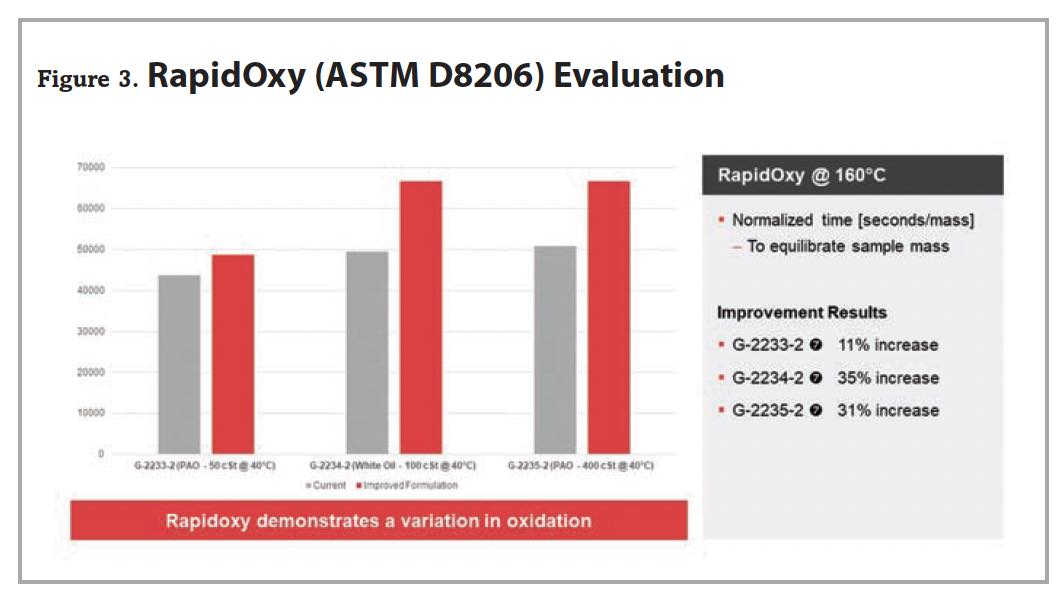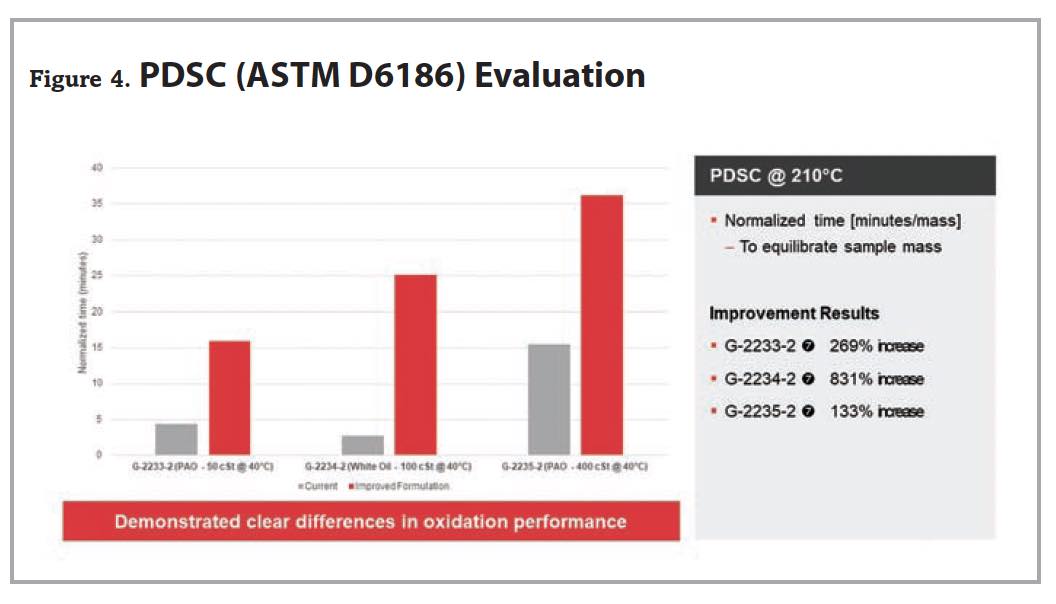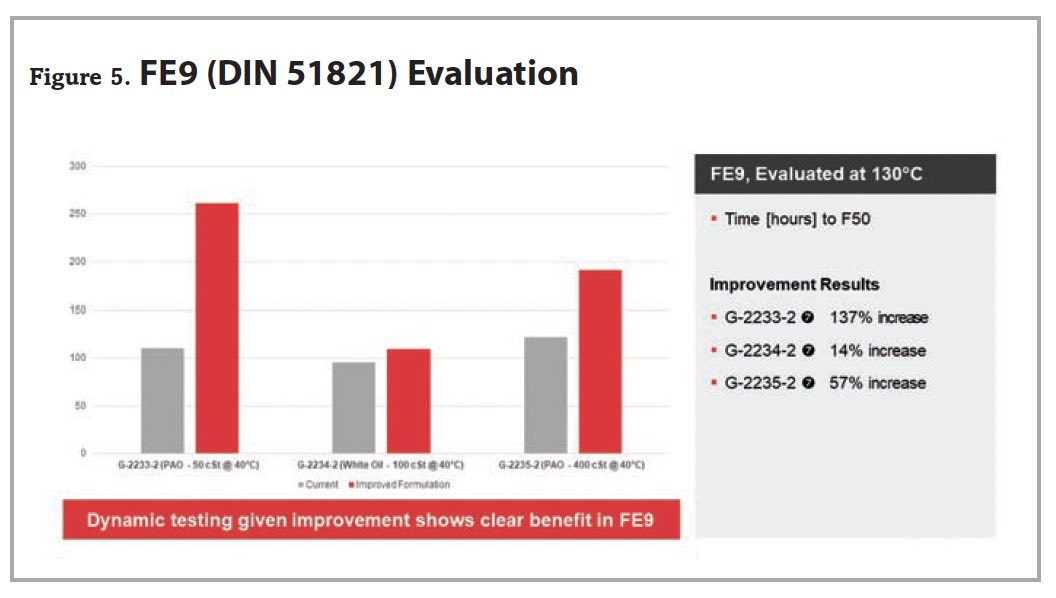LANXESS
New Generation of H1 Food Grade Calcium Sulfonate Greases
By Mary Moon, Presque Isle Innovations, LLC | TLT CMF Plus November 2023
LANXESS is commercializing a new generation of calcium sulfonate complex (CSC) thickened greases. LANXESS started commercial production of their first generation of CSC greases in 1984. In comparisons with lithium, lithium complex and polyurea greases in laboratory tests and field trials, they provided superior overall performance and service life under wet, hot, and high shock load conditions such as those in steel, pulp and paper mills. In 2001, LANXESS introduced their second generation of CSC greases, which were formulated to meet all the requirements for incidental contact food grade (FG) lubricants. The new generation of FG CSC greases is formulated with improved, safer antioxidants. All of their performance properties are as good or better than those of the previous generation of CSC FG greases. (see Fig. 1)

LANXESS AG (Cologne, Germany) is a leading global supplier of more than 660 synthetic base stocks, additives and fullyformulated lubricants to over 800 customers worldwide. The lubricant additive port - folio includes antioxidants, detergents (sulfonates), anti-wear compounds, extreme pressure additives, corrosion inhibitors, friction modifiers and industrial additive packages. The base stock portfolio includes high viscosity polyalphaolefins (PAOs), synthetic esters, and phosphate esters.
“At LANXESS, innovation means constant learning and improving our lubricants and additives to deliver the highest value,” notes Ross Dworet, Global Product Manager for Detergents (Sulfonates) within the Lubricant Additives Business (Shelton, Connecticut). “The cost-benefit ratios of the new food grade greases are a significant advantage for our customers and end users. These greases are based on a technology platform that was perfected at our Application Technology Centre (West Hill, Canada). We view these greases as the best choice for our customers looking to market food grade compliant greases.”
Wayne Mackwood, Global Head of Detergent and Grease Technology, leads a highly skilled, dynamic and dedicated team of chemists at the West Hill Technology Centre. He explains, “We built upon our deep experience with CSC greases as a starting point for the reformulation of three core food grade greases to comply with new standards for health and safety. The properties of these three updated formulations are equivalent to or better than those of the previous generation.”
CSC Greases
The unique structure and properties of CSC thickeners provide many advantages. (see Fig. 2)

Mackwood explained, “We make greases thickened with CSC from optimized combinations of raw materials and processing conditions. We are back integrated into the production of overbased calcium sulfonate and control its composition. During production, the ingredients react and arrange to form micelles. Each microscopic micelle has a core that contains stacks of calcite calcium carbonate (CaCO
3) crystals and a stable oil-soluble shell. The calcite crystals serve as barriers to water to improve corrosion resistance and control the release of oil under applied shear stress. No other grease thickener has this unique structure and combination of outstanding tolerance to heat, water and high loads.”
Global production of calcium sulfonate greases increased from 26,063 MT (2.2% of global production by volume) in 2013 to 55,770 MT (4.8%) in 2022 according to NLGI surveys. Commercial production is surging at 8.8% CAGR (2013-2022). CSC grease is replacing lithium grease in certain applications.
Food Grade Greases
Chemists at LANXESS have developed more than a dozen high performance H1 CSC grease formulations covering an extensive range of oil viscosities and types. These greases comply with US Food and Drug Administration (FDA) 21 CFR 178.3570 while exceeding the performance of other lubricating greases in the food processing market.
H1 FG lubricants are certified for safe use in applications where incidental food contact may occur. Incidental food contact is defined as unintentional contact by minimal amounts such as accidental drips or splashes of lubricant. The end user, at least in North America, is required to ensure that less than 10 ppm of the finished lubricant is transferred to the foodstuff. Ideally, H1 FG lubricants should be used in all stages of food production, processing, man - ufacturing, packaging (including its manufacture) and possibly agriculture.
Food grade lubricants are registered as H1 by a number of third-party organizations including NSF (US/EU), 2Probity (EU), CFIA (Canada), and AQIS (Australia). A newer system, ISO 21469, has been gaining popularity as a true certification method that encompasses chemistry and manufacturing processes. It has become commonplace to evaluate and certify H1 compliant FG lubricants as pareve Kosher and permissible Halal products. Any food processor using the HACCP (Hazard analysis and critical control points) system for food safety management must use an appropriate level of food grade lubricant to meet standard practices.
LANXESS commercialized the first H1 CSC grease in 2001. After a decade of R&D and field trials, Mackwood recognized, “Performance is no longer a reason to not use FG greases. Calcium sulfonate grease brings industrial level performance to the food grade market. Our CSC FG greases have outstanding tolerance of heat, water and high-pressure conditions like those common in agriculture and processing of food and beverages, and they meet all requirements for H1 registration. Most if not all of LANXESS’ portfolio of H1 FG compliant CSC greases meet the new core specification for NLGI High-Performance Multiuse (HPM) grease, and several qualify for additional HPM tags.” (see Fig. 2)
Dworet observed, “Markets for FG greases are expanding worldwide. There is increased understanding of their benefits, and there are more regulations to control risks associated with production of food and beverages. The FG grease market is well established in the Americas and Europe while continuing to emerge in Asia. Food processing and handling safety are key to securing a safe, healthy, and sustainable food supply. FG lubricants are even used in upstream applications such as handling lines for produce and pellet mills.”
New CSC FG Greases
The European Chemicals Agency (ECHA) recently re-classified certain oil-soluble antioxidants (AOs) as H361f Reproductive Toxicants, i.e., substances suspected of damaging fertility. This change included AOs used in FG CSC greases in the LANXESS portfolio.
Dworet explained, “These antioxidants remain classified as HX-1 on the 21 CFR 178.3570 list and still meet FDA requirements for use at historic treat rates in H1 lubricants. However, it became necessary to add H361f classification to the labels of our products. Instead, LANXESS was pro - active and replaced these AOs.”
Mackwood agreed, “We took advantage of our 20 years of experience formulating CSC greases to replace the AOs and optimize new formulations for three FG CSC H1 compliant greases. We maintained their performance properties and raised the bar for FG grease longevity. The 4-ball test results were even better for our new products.”
The NLGI 2 grades of the first three updated greases, G-2233-2, G-2234-2 and G- 2235-2, are smooth and tan with 605°F dropping points (ASTM D2265). They are ideal for use in humid environments, have excellent water resistance (<3% removed, water washout at 80°C, D 1264) and can withstand processing line washes and flushes. As CSC greases, they have an inherent high tolerance to acidic conditions such as citrus fruits and tomatoes. Test results for all three greases are excellent:
•
Manage heavy loads (weld points 400 and 500 kg, 4-Ball EP, D 2596)
•
Good wear performance (wear scars 0.38 and 0.39 mm, 4-Ball Wear, D 2266)
•
High mechanical stability (3%, 5% and -6% change, Mechanical Worked Stability, D 217, 10,000 strokes) for long service life.
G-2234-2 is a cost-effective high-performance H1 CSC grease based on white oil (95 cSt at 100°C, D 445) with operating range from approximately -18°C~-29°C to 170°C.
G-2233-2 is formulated with low viscosity PAO (53 cSt at 100°C, D 445). It has a wide temperature range for good performance (from -40°C to 170°C~200°C), and is especially useful at lower temperatures.
G-2235-2 is formulated with high viscosity PAO (400 cSt at 100°C, D 445). Mackwood recommends it for applications where the lubricant is exposed to elevated temperatures for extended periods of time. The higher viscosity enhances the formation of tribo-films, and the lower volatility and better thermal stability of the higher viscosity PAO raise the operating temperature of G-2235-2 above that of G-2233-2.
As this upgrade involved replacement of the current AO, the oxidation properties of the reformulated greases were examined carefully. The West Hill team employed three new instruments in addition to ASTM D942 and D3527.
A RapidOxy 100 Oxidation Stability Tester was used to measure oxygen absorption in a sealed system (D 2206). Results were significantly better for the reformulated greases. (see Fig. 3)

Pressure differential scanning calorimetry (PDSC, D 6186) was applied to evaluate thermo-oxidative stability. At 210°C, the time for a sample to equilibrate (per unit mass) was substantially better (longer) for the new greases. (see Fig. 4)

An FE9 test rig was used to perform mechanical-dynamic tests for greases in ball and roller bearings between 100°C and 200°C (DIN 51821). At 6000 rpm with 1500 N load until failure, the benefits of reformulation were clear. (see Fig. 5)

“Reformulating these CSC FG greases is an excellent example of how LANXESS continues to do more than maintain compliance. We raise the bar on the performance of our products and continue to demonstrate our capabilities as a leader in performance for private label H1 CSC greases,” Dworet concluded.